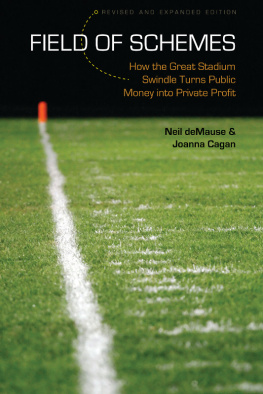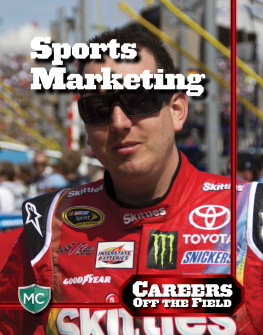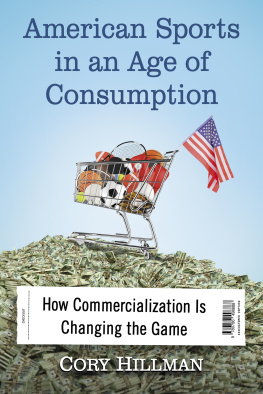A thoughtful and comprehensive examination of the curious issue of love and money in sport. Frank Deford, Senior Contributing Writer at Sports Illustrated and author of The Entitled
A well-written and poignant analysis of Americas stadium mess.Andrew Zimbalist, Robert A. Woods Professor of Economics, Smith College, and author of In the Best Interests of Baseball? The Revolutionary Reign of Bud Selig
If this book had been around for the Greeks to read, they would have learned that they shouldve billed Troy for the horse.
Molly Ivins, newspaper columnist, political commentator, and best-selling author
The authoritative book on stadium boondoggles across the country.Minneapolis City Pages


2008 by Neil deMause and Joanna Cagan
All rights reserved
Library of Congress Cataloging-in-Publication Data
deMause, Neil.
Field of schemes : how the great stadium swindle turns
public money into private profit / Neil deMause and Joanna Cagan. Rev. and expanded ed.
p. cm.
Rev. ed. of: Field of schemes / Joanna Cagan and Neil deMause.
Includes bibliographical references and index.
ISBN 978-0-8032-6016-0 (pbk. : alk. paper)
ISBN 978-0-8032-8548-4 (electronic: epub)
ISBN 978-0-8032-8549-1 (electronic: mobi)
1. StadiumsUnited StatesFinance. 2. Sports facilitiesUnited StatesFinance. 3. Sports and stateUnited States.
I. Cagan, Joanna. II. Cagan, Joanna. Field of schemes. III. Title.
gv415.d46 2008796.06873dc222007033590
The publisher does not have any control over and does not assume any responsibility for author or third-party websites or their content.
For Jordan Eli Nass-deMause
&
Finlay Cagan Patterson,
with love.
Contents
by Neil deMause
The View from the Cheap Seats
Preface to the New Edition
Neil deMause
When we sat down to begin reporting the articles that ultimately became the first edition of this book, we were only dimly aware that we were witnessing the beginnings of an epochal shift in the sports landscape. In more and more cities, owners of sports teams were demanding new publicly financed stadiums at hundreds of millions of dollars a pop, even as local governments pleaded poverty when it came time to allocate funds for such trivialities as schools or libraries. It seemed a curious moment in the worlds of both sports and urban politics, and we set out to document it before it disappeared.
That moment was now almost twelve years ago, and the little trend that we noticed then has become a massive industry. No one keeps reliable figures on how much taxpayer money goes to building new homes for sports teamsthough this book details some of the best guessesbut its certainly now in the neighborhood of $2 billion a year. The reasons given are largely the same: Sports subsidies are good for economic development, the old place is obsolete, youll lose your team if you dont build one. And, as we explain here, theyre still almost entirely bogusas when, for example, Florida Marlins team president David Samson declared a series of firm deadlines for state legislators to approve a stadium deal, and then, when no cash was forthcoming, simply waited a year and tried again.
This newly expanded edition of Field of Schemes picks up where the previous one left off, with four new chapters that investigate some of the most notable stadium and arena controversies of the new millennium. Chapter 13, The Art of the Steal Revisited, covers the tricks of the trade of stadium seekers, and how theyve changed (and more often, havent) over the years. Chapter 14, Youppi! Come Home, details what baseball business writer Doug Pappas dubbed the Stadium Extortion across North America Tour that Major League Baseball conducted as it sought to wring maximum profits from the orchestrated demise of the Montreal Expos. Chapter 15, The Perfect Storm, recounts the blizzard of new-stadium deals that hit New York City in the new millennium, with a public price tag of more than $2 billion. And chapter 16, Saving Fenway, is the story of that rare group of citizen activists who took on the combined power of the sports industry and the local political establishment, and won.
In addition, annotations have been added to the original chapters of this book, bringing their stories into the present dayso if youre wondering how Clevelands new stadiums look as an economic-development project more than a decade down the road, youll find out here. (Hint: not good.)
The little story that we stumbled across more than a decade ago turns out to be one of the defining themes of our political culture: How one big-money industry has manipulated democratic institutions to boost its own profits. The stories in this book are not just about sports, or even tax money, but ultimately about something more fundamental: Who does our government serve, and why?
Introduction
The View from the Cheap Seats
B ack in the dim, distant past, when the Earth was new and the Carolina Hurricanes were still the Hartford Whalers, we knew little about the world of sports-franchise roulette. We probably were about as informed as any regular newspaper reader or ESPN junkienamely, we knew that sports teams seemed to be moving to new cities, or at least threatening to do so, at an alarming pace. Those that stayed put were more often than not rewarded with new sports palaces with odd corporate names like the TWA Dome and the Pepsi Center. We might have wondered, too, whether these new sports facilities were really worth the hundreds of millions of public dollars being spent on them. And we might have questioned, in idle conversation, the wisdom of spending such exorbitant amounts of money on behalf of private interests while so much of what we knew and loved about U.S. cities was falling apart.
Mostly, all we knew back then, in the fall of 1995, was that the Cleveland Browns were no more.
Each of us had a long history as a sports fan. Joanna grew up in Cleveland, singing the Browns Christmas song in sixth-grade choir and generally confident in the notion that football and Sunday afternoons would forever go together. The announcement in November 1995 that longtime owner Art Modell was yanking the team away to Baltimore stunned locals. If this could happen to one of the most devoted fan bases in the country, it could happen anywhere.
Suddenly, the topic of team relocation and stadium construction seemed to deserve greater scrutiny. Local taxpayers had handed over hundreds of millions of dollars for a new baseball stadium for the Indiansshould they have done the same for the Browns? And at what point was it fair for a beleaguered populace, facing a neglected educational infrastructure and a continued urban exodus, to say enough is enough; we deserve to have sports teams and a successful school system?
For Neil, meanwhile, growing up a Yankees fan meant riding the subway to the newly renovated ballyard in the Bronx thirty times a year, to sit in $1.50 bleacher seats with a crowd more diverse than youd find most anywhere in a rapidly polarizing city: Latino families from the surrounding neighborhoods, members of the rap group Grandmaster Flash and the Furious Five, a Japanese newspaper reporter who happily gave up her press-box seat to sit with the real fans, and an elderly cowbell-wielding man named Ali, who commuted from his native Puerto Rico every baseball season to watch his team in action.
Next page








